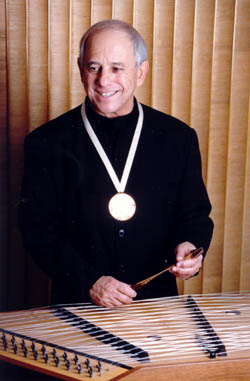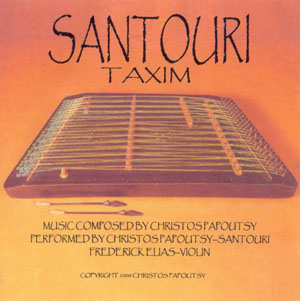
Christos Papoutsy
|
The Hellenic and Near Eastern Musical Society presents a new CD featuring 25 minutes of santouri taxim with violin accompaniment. Available for purchase at $5 each, this CD showcases one of the distinct features of Greek and Near Eastern music -- unique improvisatory passages known as
taxims (or
taximia.)
Christos Papoutsy, co-conductor and founder of the Society's 25-piece orchestra, composed the music on the CD. His performance on the santouri is accompanied by violinist Frederick Elias, one of the most celebrated living exponents of this musical genre. The CD can be obtained by writing to: Hellenic and Near Eastern Musical Society, P.O. Box 710, Rye Beach NH 03871, or by calling (603-431-9433). The e-mail address for the Hellenic and Near Eastern Musical Society is: santouri@aol.com.
A taxim is a non-metric instrumental improvisation. It represents modal melodic and occasionally rhythmic skeletal formulae upon which the performer improvises. This combination of improvisation and underlying formulaic structure presents an infinite source of musical expression, flexible and free, leading to a creation that cannot be assigned to a stable metrical order.
The free-meter improvisational sections are performed metrically by solo instruments, but at times by a small group of two or three players, with one musician leading the improvisation. Each taxim is unique, performed differently, but always drawing upon the inner depths of emotion and feeling of the lead performer. Taxims, or taximia, constitute an essential component of Hellenic and Near Eastern music, based firmly upon an intricate musical system of modes and combination modes. Some of the more common modals used are Hejaz, Hejaz Karr, Suzinak, Kourdi, Subah, Ajam, Tarznaween, Nehawand, Oussak, Ajamrust, and Segah Bouselik.
The santouri, an eastern version of the dulcimer, is ideally suited to improvisational technique. An equal-sided trapezoid, it bears more than 100 horizontally stretched strings. Bridges divide the sections of strings. Both polyphonic and monophonic sound may be produced by striking the strings with specially designed sticks called mallets. Music produced from santouri taxims has been a traditional feature of both island and mainland music in Greece and the Middle East.



